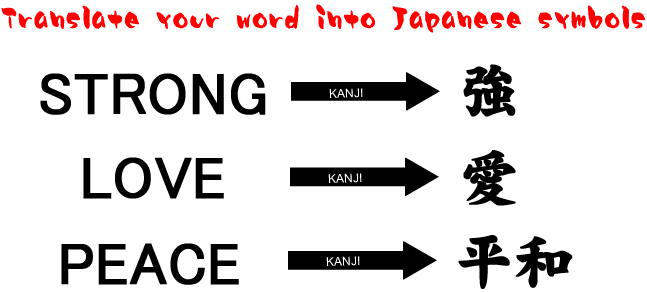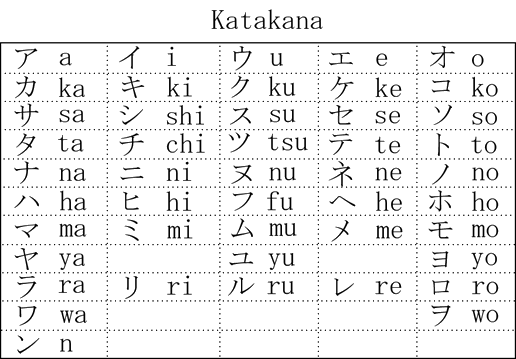How to translate my name to kanji


Now that we have how to translate my name to kanji katakana we can transcribe this into Kanji by looking at Kanji with those readings in a dictionary, and this can be quite a time-consuming process. There are many Kanji with the same readings, all with different meanings. When looking for Kanji to transcribe names keep in mind the following: 1 The meaning of the Kanji. Be careful with selecting Kanji with definitions that would be offensive, vulgar, or plain silly. This is hard to do. When I translated my name, Esteban, for my hakama I had a hard time making all the kanji coherently mean something. I settled for a combination that mostly looked cool when I brushed them in calligraphy. Native Japanese names almost always use KUN readings only. I usually look for ON readings when translating western names. Except for the first kanji, all of them use the ON reading. The first one, maru, is the KUN reading. Remember, if you mix them is going to make it harder for someone else to read and decipher the name.
We have two students who are getting their black belts soon which had quite challenging names. One was Thurber. These kanji mean tiger, place, and charming. I know some folks frowned upon westerners writing their names in Kanji. Names are written in Japanese by how they are pronounced, not by how they are spelled.

Recently katakana has been further modified to better render non-Japanese pronunciations. Katakana and Japanese Seals One problem with katakana is also its strength: the upside is the lines are simple and angular and can be written quickly, the downside is this leaves little room for artistry. This makes katakana easy to write, but the simple and angular lines do not have a cursive or even most semi-cursive fonts. Requiring that katakana be used for all non-Japanese names present problems. This script is complex and how to translate my name to kanji which makes it more difficult to forge. Because of this feature, seals have been written using Seal Scripts for thousands of years. The problem is that Seal Scripts predate the creation of katakana by several thousand years and is only defined for use with kanji. This contradiction means that a rule is going to have to be broken.
And once we begin breaking rules, the best we can do is look to precedent on how to proceed. This is where things get interesting. To avoid confusion with what I have just stated, I would like to clarify one point about seals.
In Japan, there are two types of seals. One is called inkan, this is used for everyday how to translate my name to kanji. The other is called tenkoku lit. If my name were Yamada, I could go down the street to a stationary store and buy a pre-made inkan for Yamada. This seal, this inkan, could be used for all daily purposes as the Japanese equivalent of a signature. However, for legal purposes, such as for opening a bank account, this seal could not be used.

One would need https://ampeblumenau.com.br/wp-content/uploads/2020/02/archive/photography/how-to-clear-your-history-on-instagram.php have a unique and complex seal that is registered with the government and for this purpose, the tenkoku seal must be used. To illustrate this point I compare the styles below. These are different seals for Sairei which is my professional name in Japan. Figure 1 is how the seal would look using katakana, 2 is a regular font that would be suitable for an inkan seal, and 3 is a Seal Script design which would be common design for a tenkoku seal. As Japanese is a language of syllables, it is awkward to translate initials. The method used is to translate how the letters are pronounced.
Game development, technology, and Japan.
Today hiragana is used to write grammatical elements, adjective and verb inflection, and native words for which kanji either does not exist or is not commonly used. In Japan, male and female given names can be written in hiragana so there is not a hard gender distinction. For non-Japanese names where the norm is to use katakana, however, it becomes an aesthetic choice. As hiragana can be much more feminine, women will sometimes prefer hiragana to write their given name. But do keep in mind that katakana has been modified so that it is particularly well-suited to write non-Japanese names and words. Standard hiragana does not have the same modifications.

For example, the enchou fugou is not supposed to be used with hiragana though one does see it. With Kathy kyashii this is not an issue as many Japanese words treat the duplicate vowel as a vowel extension. And while this convention always works for Japanese words, it often falls apart for non-Japanese words. In hiragana it would be ambiguous and, in fact, one does not see it written in hiragana. This should not be used and has its own issues. Names that used the enchou fugou character in katakana would double the vowel in hiragana.
Kelly written in hiragana 78and 9 horizontally from left to right 1011and 12 vertically from top to bottom. In this dictionary I have opted for the spelling closest to the actual pronunciation. Earlier sources tend to use a B sound instead, so for example Kevin is often pronounced kebin rather than kevin. For the sake of consistency, I have used the more accurate notation throughout this dictionary.
Each one has been individually checked, and errors are extremely uncommon. There are plenty of resources available online. Search this website: Using the Images The images produced by this dictionary are free for personal use.
How to translate my name to kanji - excellent and
Kanshudo tracks your mastery knowledge of every kanji, word and grammar point in Japanese individually. In item searches Kanji searchWord search and Grammar searchyou will see a small circle with a number from 0 - how to translate my name to kanji next to each item, where zero means read article mastery' and 4 means 'absolute mastery'. A summary of your mastery data is displayed in your KanjiWord and Grammar mastery wheels. The kana are the most useful characters in Japanese, source we recommend you thoroughly learn all kana before progressing to kanji.All how order chicken online in bangalore in our system are rated fromwhere 1 is the most useful. All words in our system are rated fromwhere 1 is the most useful. Words with a usefulness level of 9 or better are amongst the most useful 50, words in Japanese, and have a colored badge in search results, eg: Many useful words have multiple forms, and less common forms have a badge that looks like this: For more details on Kanshudo usefulness levels and how to use them for your studies, read our comprehensive guide, How to prioritize Japanese vocabulary to study.
Kanshudo displays a badge indicating which level of the JLPT words, kanji and grammar points might first be used in: indicates N5 the first and easiest level indicates N1 the highest and most difficult You can use Kanshudo to study for the JLPT. Kanshudo usefulness levels for kanji, words and grammar points map directly to JLPT levels, so your mastery level on Kanshudo is a direct indicator of your readiness for the JLPT exams. To add EUdict alongside Google, Yahoo! Except for the first kanji, all of them use how to translate my name to kanji ON reading.
Please Today: How to translate my name to kanji
| How to translate my name to kanji | 843 |
| What is the best free music downloader | There are two Japanese-English (and Japanese-French) how to translate my name to kanji and one contains Kanji and Kana (Kana in English and French pair due to improved searching).
For the same reason the Chinese dictionary contains traditional and simplified Chinese terms on one side and Pinyin and English terms on the other. Browser integration (Search plugins). Primary SidebarHighlight or right-click on a section of text and click on Translate icon next to it to translate it to your language. Or, to translate the entire page you're visiting, click the translate icon on the browser toolbar. Jun 12, · Chinese Tattoos vs Japanese Kanji Tattoos. The Japanese Kanji are essentially Chinese words, the ancient Japanese borrowed and adapted it into their Nippon-Go language, thus the words and meaning are the same, only the pronunciation is different. The ‘worm’ like Japanese words are originally Japanese, but not the Kanji words. |
| How to translate my name to kanji | 177 |
| What time does mcdonalds serve regular food | 875 |
How to translate my name to kanji Video
How to Make Your Original KANJI NameWhat level do Yokais evolve at? - Yo-kai Aradrama Message